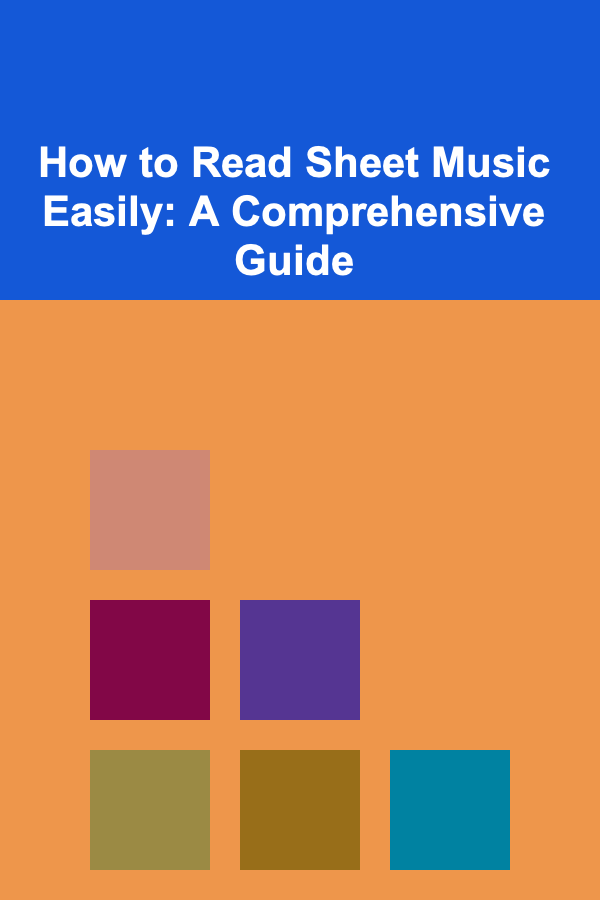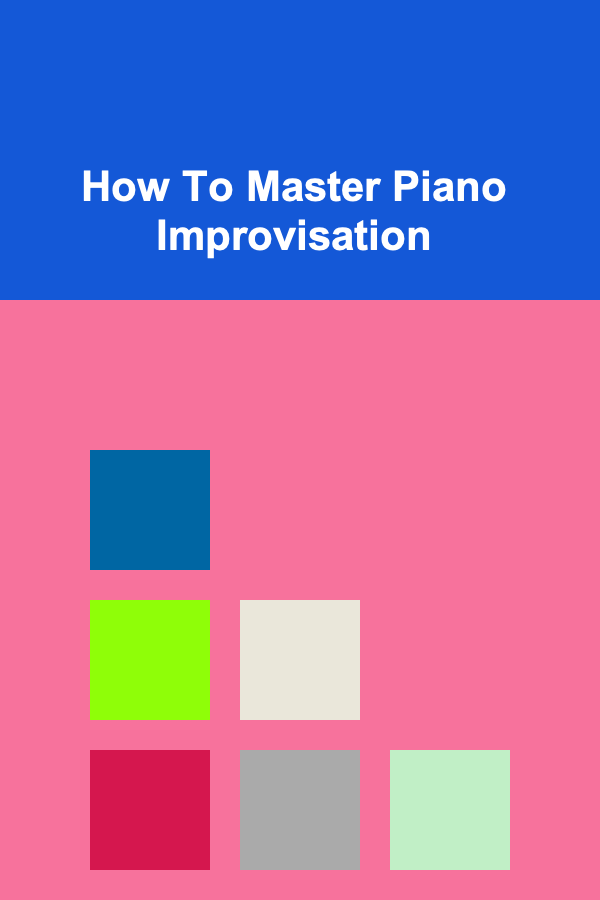
How to Read Sheet Music Easily: A Comprehensive Guide
ebook include PDF & Audio bundle (Micro Guide)
$12.99$5.99
Limited Time Offer! Order within the next:

Reading sheet music can seem daunting at first, like deciphering a secret code. But with a systematic approach and dedicated practice, anyone can learn to unlock the musical language written on the page. This guide will break down the core components of sheet music, providing a clear and comprehensive path to becoming a confident music reader. We'll start with the basics, and progressively build your understanding to encompass more complex elements. Forget the intimidation -- let's embark on a journey to musical literacy!
Understanding the Fundamentals
Before diving into the details, let's establish the fundamental building blocks of sheet music:
The Staff (Stave)
The staff, or stave, is the foundation upon which all musical notation is built. It consists of five horizontal lines and four spaces. Notes are placed on these lines and spaces to represent different pitches (how high or low a sound is). The higher a note is placed on the staff, the higher its pitch.
Think of the staff as a musical ladder. Each rung (line) and the space between each rung (space) represents a different note. The specific notes assigned to each line and space depend on the clef.
Clefs: The Key to Pitch
A clef is a symbol placed at the beginning of the staff that indicates which notes correspond to which lines and spaces. The two most common clefs are the Treble Clef and the Bass Clef.
Treble Clef (G Clef) 𝄞
The treble clef, often called the G clef, is commonly used for higher-pitched instruments and voices, such as the violin, flute, clarinet, and soprano voice. It's easily recognizable by its elegant swirl that circles the second line from the bottom. This line represents the note G above middle C.
Mnemonic Devices for Treble Clef:
- Lines (from bottom to top): E G B D F (Every Good Boy Does Fine)
- Spaces (from bottom to top): F A C E (FACE)
Understanding these mnemonics will quickly allow you to identify notes on the treble clef.
Bass Clef (F Clef) 𝄢
The bass clef, also known as the F clef, is used for lower-pitched instruments and voices, such as the cello, bass guitar, trombone, and bass voice. It has a distinctive shape with two dots placed above and below the fourth line from the bottom. This line represents the note F below middle C.
Mnemonic Devices for Bass Clef:
- Lines (from bottom to top): G B D F A (Good Boys Do Fine Always)
- Spaces (from bottom to top): A C E G (All Cows Eat Grass)
Just like with the treble clef, memorizing these mnemonics will greatly accelerate your ability to read bass clef notation.
Notes: Representing Pitch and Duration
Notes are the symbols that represent both the pitch (how high or low) and the duration (how long) a sound should be played. The shape of the note indicates its duration, while its position on the staff (line or space) indicates its pitch.
Note Durations
Understanding note durations is crucial for playing music accurately. Here's a breakdown of the most common note durations:
- Whole Note: The longest note in common use. It's represented by an open oval and typically lasts for four beats in a 4/4 time signature.
- Half Note: Half the duration of a whole note. It's represented by an open oval with a stem and typically lasts for two beats in a 4/4 time signature.
- Quarter Note: A quarter of the duration of a whole note. It's represented by a filled-in oval with a stem and typically lasts for one beat in a 4/4 time signature.
- Eighth Note: An eighth of the duration of a whole note. It's represented by a filled-in oval with a stem and a flag. Two or more eighth notes are often connected by a beam. They typically last for half a beat in a 4/4 time signature.
- Sixteenth Note: A sixteenth of the duration of a whole note. It's represented by a filled-in oval with a stem and two flags. Two or more sixteenth notes are often connected by two beams. They typically last for a quarter of a beat in a 4/4 time signature.
The relationship between note durations is always based on division by two. A whole note is twice as long as a half note, a half note is twice as long as a quarter note, and so on.
Rests: Moments of Silence
Just as notes represent sounds, rests represent periods of silence. Each note duration has a corresponding rest of the same duration:
- Whole Rest: A solid rectangle hanging below the fourth line of the staff.
- Half Rest: A solid rectangle sitting on top of the third line of the staff.
- Quarter Rest: A squiggly line that resembles a stylized number "2".
- Eighth Rest: A slanted line with one flag.
- Sixteenth Rest: A slanted line with two flags.
Paying attention to rests is just as important as playing the notes themselves. They contribute to the rhythm and phrasing of the music.
Ledger Lines: Extending the Staff
Sometimes, notes fall outside the range of the five lines and four spaces of the staff. In these cases, we use ledger lines. Ledger lines are short lines that extend the staff both above and below, allowing us to notate higher and lower notes. They act as temporary extensions of the staff, each representing a specific pitch.
The most common ledger line you'll encounter is the one for middle C, which sits below the treble clef and above the bass clef.
Understanding Rhythm and Time
Rhythm is the arrangement of sounds and silences in time. It's what gives music its pulse and groove. Understanding the components of rhythm is essential for accurately interpreting sheet music.
Time Signatures: The Rhythmic Blueprint
The time signature, placed at the beginning of a piece of music (and sometimes within the piece if the time signature changes), tells you how many beats are in each measure (or bar) and what kind of note gets one beat. It appears as two numbers stacked on top of each other.
- Top Number: Indicates the number of beats in each measure.
- Bottom Number: Indicates what type of note receives one beat.
Common Time Signatures:
- 4/4 Time (Common Time): Four beats per measure, with the quarter note receiving one beat. This is the most common time signature in Western music.
- 3/4 Time: Three beats per measure, with the quarter note receiving one beat. Often used in waltzes.
- 2/4 Time: Two beats per measure, with the quarter note receiving one beat.
- 6/8 Time: Six beats per measure, with the eighth note receiving one beat. Often has a feeling of two groups of three beats.
For example, in 4/4 time, you would count "1, 2, 3, 4" for each measure. In 3/4 time, you would count "1, 2, 3" for each measure.
Measures (Bars): Grouping the Beats
A measure, or bar, is a segment of time corresponding to a specific number of beats, as indicated by the time signature. Measures are separated by vertical lines called bar lines.
Bar lines help organize the music visually, making it easier to follow the rhythm and phrasing.
Beats: The Underlying Pulse
The beat is the basic unit of time in music. It's the steady pulse that you feel as you listen to a song. The time signature tells you how many beats are in each measure.
Tempo: The Speed of the Music
Tempo refers to the speed at which the music is played. It's usually indicated at the beginning of a piece of music with a tempo marking, such as "Allegro" (fast) or "Adagio" (slow). Tempo markings can also be expressed in beats per minute (BPM), such as "♩ = 120" (quarter note equals 120 beats per minute).
Understanding tempo is crucial for capturing the intended mood and character of the music.
Dots and Ties: Extending Note Durations
Dots and ties are used to modify the duration of notes:
- Dot: A dot placed after a note increases its duration by half its original value. For example, a dotted quarter note is equal to a quarter note plus an eighth note.
- Tie: A curved line connecting two notes of the same pitch. The tied notes are played as one continuous note with a duration equal to the sum of the durations of the tied notes.
Dots and ties allow for more complex rhythmic patterns that wouldn't be possible with simple note values alone.
Accents: Emphasizing Specific Beats
Accents are symbols that indicate which notes should be played with more emphasis. They add dynamic variation and rhythmic interest to the music.
Common accent markings include:
- > (Accent Mark): Indicates that the note should be played with a strong emphasis.
- ^ (Marcato): Indicates that the note should be played with a sharp, accented attack.
- - (Tenuto): Indicates that the note should be held for its full value or slightly longer.
Understanding Melody and Harmony
While rhythm provides the temporal framework of music, melody and harmony add the expressive elements that make music engaging and beautiful.
Melody: The Horizontal Dimension
Melody is a sequence of notes that creates a musical idea. It's the "tune" of a song. In sheet music, the melody is typically represented by a single line of notes.
Understanding melodic contours -- the rise and fall of the notes -- is crucial for interpreting the expressive intent of the music.
Harmony: The Vertical Dimension
Harmony is the combination of different notes played simultaneously to create chords. Chords provide a harmonic backdrop for the melody and add depth and richness to the music.
Understanding basic chord structures and progressions is essential for playing and analyzing music.
Chords: Building Blocks of Harmony
A chord is a group of three or more notes played together. The most common type of chord is a triad, which consists of three notes: the root, the third, and the fifth.
Common Chord Types:
- Major Chord: A bright and cheerful-sounding chord.
- Minor Chord: A sad and somber-sounding chord.
- Diminished Chord: A dissonant and unstable-sounding chord.
- Augmented Chord: A dissonant and unstable-sounding chord.
Chords are often indicated in sheet music with chord symbols above the staff, such as "Cmaj7" (C major seventh chord) or "Gmin" (G minor chord).
Key Signatures: Establishing the Key
The key signature, located at the beginning of the staff after the clef, indicates which notes are consistently sharp or flat throughout the piece. It helps establish the key of the music, which is the central tonal center around which the melody and harmony revolve.
Key signatures are indicated by a series of sharps (#) or flats (♭) placed on specific lines and spaces of the staff. The order of sharps and flats is always the same:
- Order of Sharps: F C G D A E B
- Order of Flats: B E A D G C F (the reverse of the order of sharps)
For example, a key signature with one sharp (F#) indicates the key of G major or E minor. A key signature with two flats (Bb and Eb) indicates the key of Bb major or G minor.
Accidentals: Altering Pitch
Accidentals are symbols that alter the pitch of a note temporarily. They include sharps (#), flats (♭), and naturals (♮).
- Sharp (#): Raises the pitch of a note by a half step.
- Flat (♭): Lowers the pitch of a note by a half step.
- Natural (♮): Cancels a previous sharp or flat, restoring the note to its natural pitch.
An accidental applies to the note in the measure where it appears and any subsequent occurrences of that note in the same octave within that measure, unless canceled by another accidental.
Understanding Expression and Dynamics
Music is more than just notes and rhythms; it's about conveying emotion and creating a compelling listening experience. Expression and dynamics are the tools that allow musicians to shape the performance and communicate their artistic interpretation.
Dynamics: Volume Levels
Dynamics indicate the loudness or softness of the music. They are typically represented by Italian terms and abbreviations placed below the staff.
Common Dynamic Markings:
- pp (pianissimo): Very soft
- p (piano): Soft
- mp (mezzo piano): Moderately soft
- mf (mezzo forte): Moderately loud
- f (forte): Loud
- ff (fortissimo): Very loud
- cresc. (crescendo): Gradually getting louder
- dim. (diminuendo) or decresc. (decrescendo): Gradually getting softer
Dynamic markings are relative, not absolute. The interpretation of "forte" will vary depending on the instrument, the style of the music, and the overall context of the piece.
Articulation: How to Play the Notes
Articulation markings indicate how individual notes should be played. They affect the attack, duration, and connection between notes.
Common Articulation Markings:
- Staccato (•): Play the note short and detached.
- Legato (slur): Play the notes smoothly and connected.
- Tenuto (-): Hold the note for its full value or slightly longer.
- Accent (>): Play the note with a strong emphasis.
Articulation markings are crucial for conveying the intended phrasing and expression of the music.
Other Expressive Markings
Sheet music often includes other expressive markings that provide additional guidance for the performer.
- Ritardando (rit.): Gradually slowing down.
- Accelerando (accel.): Gradually speeding up.
- Fermata 𝄐: Hold the note or rest longer than its written value.
- Repeat Signs 𝄆 𝄇: Indicate sections of music that should be repeated.
- Da Capo (D.C.): Go back to the beginning.
- Dal Segno (D.S.): Go back to the sign 𝄉.
- Coda coda: An added ending section.
Tips for Learning to Read Sheet Music
Learning to read sheet music takes time and practice, but it's a rewarding skill that will greatly enhance your musical abilities. Here are some tips to help you on your journey:
- Start with the Basics: Don't try to learn everything at once. Focus on mastering the fundamentals -- the staff, clefs, note durations, and time signatures -- before moving on to more complex concepts.
- Practice Regularly: Consistent practice is key to developing your reading skills. Even short, focused practice sessions are more effective than infrequent, long sessions.
- Use Flashcards: Create flashcards to help you memorize note names, key signatures, and other musical symbols.
- Sing or Play Along: Sing or play the music as you read it. This will help you connect the written symbols to the sounds they represent.
- Start with Simple Music: Choose music that is appropriate for your skill level. Begin with easy pieces and gradually work your way up to more challenging material.
- Use a Metronome: A metronome can help you develop a strong sense of rhythm and timing.
- Don't Be Afraid to Ask for Help: If you're struggling with a particular concept, don't hesitate to ask a teacher or more experienced musician for help.
- Be Patient: Learning to read sheet music takes time and effort. Don't get discouraged if you don't see results immediately. Keep practicing, and you will eventually master the skill.
- Focus on the Rhythm First: Before even trying to sing or play the pitches, clap or tap the rhythm. This helps internalize the timing and makes adding the notes much easier.
- Learn the Landmarks: In each clef, identify a few key notes that serve as anchors. For example, in Treble Clef, locate the G (on the second line) and the C (below the staff). From these landmarks, you can more easily figure out the neighboring notes.
- Use Apps and Online Resources: There are many excellent apps and online resources available to help you learn to read sheet music. These resources can provide interactive lessons, practice exercises, and access to a vast library of sheet music.
- Transcribe Music: Try transcribing simple melodies by ear. This will help you develop your listening skills and connect what you hear to what you see on the page. Start with nursery rhymes or simple folk songs.
- Analyze Music: Take the time to analyze the music you are reading. Identify the key signature, time signature, chord progressions, and other musical elements. This will deepen your understanding of the music and improve your reading skills.
- Listen Actively: When listening to music, try to follow along with the sheet music. This will help you develop your ability to hear the music in your head as you read it.
Common Challenges and How to Overcome Them
Even with dedicated practice, you may encounter some common challenges when learning to read sheet music. Here's how to overcome them:
- Difficulty Memorizing Note Names: Use mnemonic devices and flashcards to reinforce your memory. Practice naming notes quickly and accurately.
- Struggling with Rhythm: Use a metronome and practice clapping or tapping rhythms regularly. Break down complex rhythms into smaller, more manageable chunks.
- Trouble with Key Signatures: Learn the order of sharps and flats and practice identifying key signatures quickly. Use a key signature chart as a reference.
- Confusion with Accidentals: Remember that accidentals only apply to the note in the measure where they appear. Pay close attention to the octave in which the accidental is placed.
- Inability to Sight-Read: Sight-reading (reading music for the first time) requires practice and experience. Start with simple music and gradually increase the difficulty level. Focus on accuracy over speed.
- Overwhelming Amount of Information: Break down the learning process into smaller, more manageable steps. Focus on mastering one concept at a time.
The Benefits of Learning to Read Sheet Music
Learning to read sheet music is a valuable skill that offers numerous benefits:
- Enhanced Musical Understanding: Reading sheet music deepens your understanding of music theory, harmony, and form.
- Improved Musicianship: Reading sheet music improves your ability to play or sing with accuracy and expression.
- Increased Repertoire: Reading sheet music opens up a vast library of music to explore and perform.
- Better Communication with Other Musicians: Reading sheet music allows you to communicate effectively with other musicians.
- Greater Independence: Reading sheet music allows you to learn and perform music independently, without relying on recordings or instructors.
- Cognitive Benefits: Learning to read sheet music exercises your brain and improves your memory, concentration, and problem-solving skills.
- Appreciation of Music: By understanding the structure and complexities within sheet music, you gain a far richer understanding and appreciation of the nuances within written music.
Conclusion
Learning to read sheet music is a challenging but ultimately rewarding endeavor. By understanding the fundamentals, practicing regularly, and using the tips and strategies outlined in this guide, you can unlock the musical language written on the page and embark on a lifetime of musical discovery. Don't be afraid to make mistakes, be patient with yourself, and enjoy the journey! The world of music awaits!

How to Embrace Flexibility in Your Learning Approach
Read More
How to Make Money Online as a Discord Community Manager: 10 Actionable Ideas
Read More
How to Turn Your Basement into a Functional Living Space
Read More
The Top Ways to Generate Passive Income Using Deep Learning
Read More
How To Master Piano Improvisation
Read More
How to Design Recipe Cards for Family Heirloom Recipes
Read MoreOther Products

How to Embrace Flexibility in Your Learning Approach
Read More
How to Make Money Online as a Discord Community Manager: 10 Actionable Ideas
Read More
How to Turn Your Basement into a Functional Living Space
Read More
The Top Ways to Generate Passive Income Using Deep Learning
Read More
How To Master Piano Improvisation
Read More